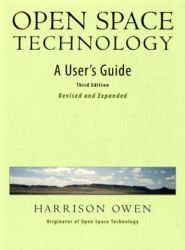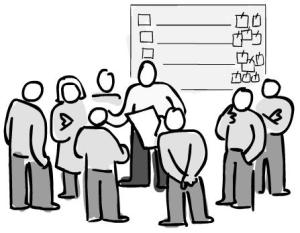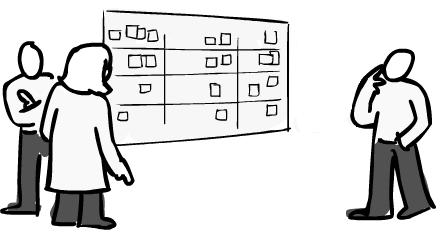Introduction
In this article I want to introduce Open Space Technology. As it is the most efficient and effective kind of problem solving meeting I get to know so far I want to share my experience with you.
 Open Space Technology is effective in situations where a diverse group of people need to deal with complex and potentially conflicting material in innovative and productive ways. It is particular powerful when nobody knows the answer and the ongoing participation of a number of people is required to deal with the question. In the Open Space environment people tend to be creative, synergistic and self motivated.
Open Space Technology is effective in situations where a diverse group of people need to deal with complex and potentially conflicting material in innovative and productive ways. It is particular powerful when nobody knows the answer and the ongoing participation of a number of people is required to deal with the question. In the Open Space environment people tend to be creative, synergistic and self motivated.
Open Space Technology was created by Harrison Owen in 1985 and combines a complex problem solving meeting with the spirit of a coffee break.
Discovering Open Space Technology
The first time I heard about Open Space was in late summer in 2009. I was participating the Scrum Gathering in Munich with some of my colleagues. It was an excellent conference with lots of interesting sessions, field reports and practical exercises. It was the first time that I attended such an agile conference at all and I was impressed by meeting so many like minded people. As I started learning Scrum mid of 2008 by private study and gained first experience by implementing Scrum in my R&D Team, I had not so much exchange of experience so far. Thus it was amazing for me to listen and talk with people who are doing Scrum on a longer term and practice the Framework Methodology.
Beside all the Sessions at the Scrum Gathering there was an Open Space organized in the lounge of the Hilton, where the conference took place.
To be honest, at that time I did not understand how OpenSpace really works and I missed the facilitated opening as it was a Guerilla Open Space. Thus for me it seemed that it was not facilitated. There were just some comments from the Organizers of the Conference that there is an OpenSpace for talks. To participate you just should place your topic at one of the corners for a special time and then wait who comes and also wants to talk with you about this topic. Ok, I understood what was explained but as this took place beside all the organized Sessions it seemd a little bit strange for me.
Seeing Open Space from the Inside
Half a year later Deborah Hartmann Preuss, an excellent agile Coach, organized an OpenSpace at my employer within an agile training. And that was the point when I started realizing what OpenSpace really is, how it works and how it needs to be organized and facilitated. For outsiders OpenSpace looks easy – when it is well prepared and well facilitated, and this is exactly the crucial skill you need to have to run an Open Space event – in my opinion
Here are the simple rules and principles for Open Space:
The Law of two feet:
If at any time you find yourself in any situation where you are neither learning nor contributing: use your two feet and go someplace else. You are encouraged to quietly withdraw and become either a Butterfly or a Bumblebee. A Bumblebee joins another group, perhaps fertilizing it while a Butterfly flies round or joins other Butterflies for informal discussion.
The four principles:
- Whoever comes is the right people
- Whatever happens is the only thing that could have
- Whenever it starts is the right time
- When it’s over, it’s over
 You need to organize space for sessions. These spaces must be equipped with flip charts and whiteboards or panels. In addition you need different Markers, StickyNotes, IndexCards, ball pens and/or felt pens, chairs in a circle and perhaps tables. Depending on the overall topic you need eventually more stuff to organize.
You need to organize space for sessions. These spaces must be equipped with flip charts and whiteboards or panels. In addition you need different Markers, StickyNotes, IndexCards, ball pens and/or felt pens, chairs in a circle and perhaps tables. Depending on the overall topic you need eventually more stuff to organize.
Additionally you need enough print outs to document the participants, outcomes and follow-ups for every session…
In the space for the open planning there must be the marketplace organized with a large panel where you can visualize the session rooms and the initial time slots in a matrix. There must be space to hang up IndexCards.
Then you also need enough IndexCards and felt-pens. Off the mark you need to place posters with the rules and principles of OpenSpace. There are just a few rules but they are very important and existential to explain to have it work and make the unconference valuable.
How It Feels to Run an Open Space Event
Before the beginning of the OpenSpace event at my employer, which was organized by Deborah, I was a little bit afraid if it could work in our company, as I just had my experience from the Scrum Gathering in Munich which was rather disappointing for me.
Given that I was supporting Deborah by organizing the OpenSpace made me feel curious as it was something completely different to what I saw half a year ago in Munich. And when we started our unconference I was more and more surprised and encouraged that this Open Space had absolutely no chance to fail, everything made complete sense to me and as Deborah is such a phenomenal facilitator she started introducing Open Space to the participants which was totally energizing. And it worked. We had a great marketplace with lots of sessions and it took us about 20-30 minutes to fill the whole matrix of spaces and time-slots.
 At the end of the day we had an amazing outcome. We posted all flipcharts and documentation of the sessions on the walls of our large conference. We had lots of follow-ups and action items planned. This was the beginning for a lot of creative collaboration and the starting point for much better communication between fellow workers. And I’m delighted to say that this event was a milestone for our company in our agile transition.
At the end of the day we had an amazing outcome. We posted all flipcharts and documentation of the sessions on the walls of our large conference. We had lots of follow-ups and action items planned. This was the beginning for a lot of creative collaboration and the starting point for much better communication between fellow workers. And I’m delighted to say that this event was a milestone for our company in our agile transition.
Applying Open Space to Technical Topics
Some month after this event we had an additional OpenSpace event in one of our R&D sites where the overall topic was a little bit more technical. You need something like a core relational theme that is still open but should put boundaries a little bit the topics so that people know why they are coming. For example, when you have an overall theme like cooking, you could have topics like, desserts, breakfast, dinner, ingridents, how to set up a kitchen etc.
The OpenSpace in our R&D Site was on the second day of a two day workshop, The first day was more strategic, about gaining insights for a technical framework. So the first day was a perfect preparation, so that participants came up with related topics and ideas so we could talk about how to address hurdles which were found in the strategic outcome one day before.
At the end of the day there were lots of valuable outcomes, follow-ups and action items, again. It developed understanding for complex topics, for example: insights about crossfunctional teams for technical problems and challenges which need to be addressed. Communication between teams increased. And once again this Open Space event was a milestone for our agile development in the company.
Trying it On My Own
In December 2010 we organized a two day agile workshop for ProductOwners. The second day was reserved for an OpenSpace. About two weeks before the workshop started, the main facilitator for theses two days got an urgent invitation from senor management with the result that he was not available for facilitating the Open Space event. I was helping to organize this event and I had already collected different experiences with OpenSpace, in addition I’m an experienced Facilitator, and so I started to think about if I could facilitate the Open Space by my self. It was not easy to decide, as Open Space needs a proper preparation and good facilitation to be successful.
After some mindmapping for myself I dared to prepare and at the end, to facilitate this OpenSpace event. I had some support from Deborah in preparing all the stuff and she helped me in mentally reviewing the upcoming Open Space. You’ll find some interesting links at the end of this article which helped me preparing.

As the event starts I was a little bit nervous. But after facilitating the first minutes and explaining the audience what Open Space is, I calmed down and just came into a good flow of facilitation.
The participants came up with a lot of great and expectant topics. Thus it was no surprise that the marketplace was filled up in just a short time.
And once again, Open Space worked. There was so much valuable outcome, community building and again follow-ups to concentrate on later. The only special thing this time – I facilitated it for myself, made a great experience and guided the people for whom Open Space was new through a great unconference.
My Conclusion about Open Space
Open Space events are powerful, efficient, effective and highly recommended kind of meetings, where all participants deal with complex and potentially conflicting topics in an innovative and productive way.
Further reading:
- Harrison Owen, the Creator of Open Space Technology
- A Story of Open Space
- Open Space Concept map
- Open Space benefits both, Beginners and Experts
- Open Space for Collaborative Conferences

Leave a comment